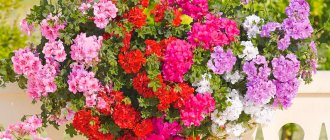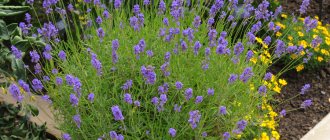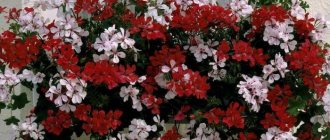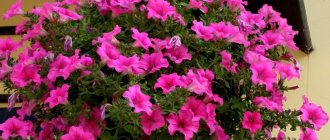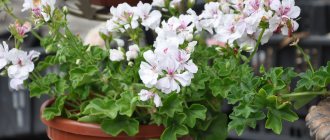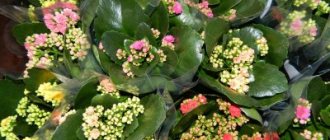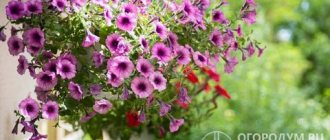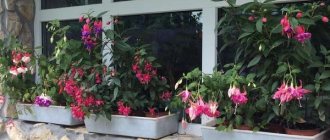How to plant lobelia?
Transplanting lobelia into pots becomes necessary if the sprouts are intertwined with leaves, roots and stems. This occurs at the stage of 2 – 3 true leaves. Even if the main plant is small, this is the optimal time for replanting. Do not forget that it is mandatory to prepare pots for replanting plants in them. You should not use glazed or porcelain dishes, because they will not allow fresh air to reach the lobelia roots. Clay is also not particularly suitable due to frequent stagnation of water. The pots should be washed with hot water and scalded with boiling water.
When to transplant lobelia into pots?
Lobelia is planted in a pot an average of a month after germination. Expanded clay should be present at the bottom of the pot, since the flower cannot tolerate stagnant moisture. You can plant them first in 100 gram cups, and then in pots or cache-pots. If planting plants in open ground was not planned, then the seeds can be immediately sown in a flowerpot or pot, and excess shoots removed. In this case, you won’t have to think about how to properly plant lobelia in pots.
After the picking process, it is necessary to have lighting and an air temperature above +15 degrees. Moderate watering is required around the bushes. After three weeks, the first feeding with a special vitamin complex should be organized. But you shouldn’t get carried away with fertilizing either; this does not always benefit the plants; often, overfeeding with fertilizers affects the flowers in the most negative way.
How to plant lobelia in pots correctly?
Planting lobelia in a pot is not as difficult as some people think. Plants are planted in several bushes, while trying not to damage the root system of each flower. The algorithm is as follows:
The soil must be added so that at least 2 cm remains from the soil to the top edge of the pot. This will make it more convenient to water the plants. Excessive zeal in watering is not necessary, as it can provoke the development of various diseases. Once a week is enough for normal development and flowering.
What size pot does lobelia like?
The volume of the lobelia pot should not be huge, otherwise the plants will simply stretch out and lose their attractive appearance. However, its diameter will depend on the type of plant. If the variety is bushy, then a pot of 600 - 800 ml is enough for one bunch. If you plan to plant lobelia with a companion, then the bunches growing in one glass do not need to be divided, although this is often written on packets of seeds.
How many lobelia plants to plant in one pot depends on the diameter of the pot itself. You can plant from 10 to 12 pieces in a pot with a diameter of 25 cm. Some housewives prefer to plant more: up to 20 plants in one pot. If there are not enough seedlings, then you can plant three of them, press the stems to the ground, after a month the bushes look like a lush head. Lobelia seedlings require less space than, for example, ampelous petunia.
Lobelia in pots interesting ideas
Lobelia in pots outside looks great together with other plants:
Several lobelia bushes in one pot look interesting, and the varieties should be different, but combined in size and color. Companion plants for lobelia should have similar care requirements. In addition, it is better to use short varieties to avoid the harmful effects of wind and rain on neighboring flowers. To make plants look impressive, you need to promptly remove faded buds and pinch shoots that have grown too long. Such simple care will allow you to admire the flowering for a long time.
The flower harmonizes perfectly with bamboo-like plants, forms a single picture with them and pleases the eyes of the owner and guests. If you want to decorate plants in a water theme, then you need to choose shades of blue or light blue. The blue color scheme in this case will become a highlight and fit perfectly into the landscape.
Source
Flower varieties
Lobelia comes in several types.
Dwarf
The plant branches heavily, reaches a height of 20 cm. The flowers are small, about 2 cm. The colors are blue, white, purple, pink. This variety, in turn, is divided into two subspecies:
The only important thing for him is that the soil is always moist.
Compact
This variety is in great demand because it can be grown not only in the garden, but also at home, on the balcony. Another compact lobelia is often used to decorate flower beds. It grows no more than 15 cm in height.
It is characterized by abundant and long flowering, which is also a huge plus. The color of the flowers is predominantly blue.
Erect
This variety is distinguished by a straight stem and a height of up to 75 cm. Lobelia of this variety prefers high humidity. For this reason, in wild places, she likes to be located next to bodies of water and wetlands.
Ampelnaya
This type of plant is characterized by the presence of long shoots. It is recommended to use flowers for flower pots and home flower beds. By color there are white, blue with a white eye or heavenly with a white eye.
The variety is quite resistant to temperature changes.
Advantages of growing from seedlings
Flower growers do not always want to grow lobelia in their gardens because they are afraid of getting into a lot of trouble. After all, the plant has very small seeds, so planting it immediately in a permanent place really turns out to be difficult.
But lobelia seedlings will help avoid problems.
Also, the advantage of growing through seedlings is that as the flowers develop, you can take measures to strengthen their immune system and protect them from pests and diseases.
As a result, crops planted in a permanent place will be many times more stable than those sown directly in open ground.
Advice from flower growers
Watering. You need to water abundantly, but so that the water does not stagnate at the roots, which can lead to blackleg disease. Pinching. To keep the bush neat, Lobelia shoots must be pinched. This is not necessary, but after pinching and trimming the bush looks more branched and fluffy. They also resort to this procedure if for some reason it is not possible to plant seedlings in open ground and the plant drags. Trimming. Around July, the plant must be substantially pruned in order for the second wave of flowering to occur. Feeding. Fertilizers should be used to a minimum
Literally 1 tablespoon of liquid fertilizer per 10 liters of water. When watering a flower, even outside, you must be very careful not to get it on the petals to avoid burns.
Preparation for the sowing procedure
For further sowing, you will need to prepare the soil and container.
What primer should I use?
For lobelia, you need to prepare the soil. The flower loves soil with the following characteristics:
You can prepare the soil yourself from soil, humus, river sand and peat in a ratio of 2:2:1:1.
If the soil is highly acidic, it is necessary to add a small amount of wood ash or dolomite flour to it before planting. These components are capable of neutralizing acid.
Before sowing, it is important to disinfect the soil using high temperature. To do this, place in the oven for half an hour, maintaining 90 degrees. Then hold it over steam for 60 minutes.
Selection of capacity
You can sow lobelia in any container; there are no strict requirements for choice. The main thing is that it is spacious and not too deep. Flower growers purchase special containers in stores or adapt something at hand.
The following options are possible:
It is important that the bottom of the container has holes for drainage. They are not required only when using peat cups and tablets.
Seed sowing process
Sowing lobelia seedlings does not require any special knowledge or skills; any novice gardener can do it. The only difficulty is that the seeds are small; they must be handled very carefully so as not to spill.
Step-by-step landing algorithm:
You can sow lobelia in rows, having previously made grooves with a distance of 2-3 cm from each other. This option is even better, as it will simplify the task of caring for plants in the future.
Seedling care
As soon as the sprouts appear, you need to move the containers to a bright place and follow the rules of care:
During the process of growing lobelia, you need to regularly check whether it has been exposed to any diseases or harmful insects.
Timely detection will help you quickly cope with troubles and save flowers.
Picking and pinching
You can pick lobelia when 2-3 full leaves appear. You should not perform the procedure earlier or, conversely, be late.
The process requires special care from the grower; it takes a lot of time and effort. The sprouts are very small; to extract each of them, you need to use a stick or a teaspoon. It is better to transfer the seedlings with tweezers directly along with the soil, so as not to harm the roots.
Pinching is carried out in order to form a neat and lush lobelia bush. When the sprout reaches a height of 4 cm, its top is trimmed using scissors pre-treated with a disinfectant.
Growing lobelia on the balcony
Many people decorate their balconies with lobelia. Familiar window sills “come to life” from such guests. Typically, the following varieties are used for growing on balconies:
- Cardinal;
- Rosamund;
- Syphilitic;
- Blue fountain;
- Dortman;
- Fiery.
The varieties described above are low-growing and densely growing - an excellent option for decorating balconies and loggias. Seedlings are planted in permanent pots, cache-pots or containers.
They dive into light and nutritious soil when the plants reach about 4-5 centimeters in height. It is convenient to replant them with a spoon, picking up the plants along with the soil. Leave about 4 centimeters between the shoots and tamp them down a little.
When they grow to 8 centimeters, the tops are pinched - we will talk about this below.
Seedlings can be transplanted onto an uninsulated balcony when the temperature outside the window remains within +15 degrees. Lobelia can withstand a one-time drop in temperature down to -2 degrees. This will not cause any problems, but only within one day.
In cloudy weather and short daylight hours, you need to highlight the sprouts. But, despite their addiction to light, direct sunlight should be avoided, especially through glass - they can die. The most ideal temperature for flowering is 25 degrees Celsius.
Since this species loves humidity, it needs to be maintained at 50-60%. They need to be watered every day. At the same time, you cannot overfill. Water should be absorbed into the soil without leaving any residue. On a particularly hot day, it is better to water them twice – in the morning and in the evening. Be sure to make holes at the bottom of the pots for ventilation and release of excess moisture.
Watering is carried out strictly under the root. Droplets of water on a plant on a hot sunny day can cause severe burns. It is better to fertilize the plants on the balcony 2 times a month with mineral substances for flowers, according to the instructions. At the same time, it is better to avoid fertilizers with a high nitrogen content. In excess, it leads to slower growth.
Transplanting into the garden
Before planting the plants in a permanent place, they need to be hardened off. This way they will be less stressed and adapt better to new conditions. To carry out hardening, you will need a temperature of at least 13 degrees above zero.
It is important to start the procedure at least a week before the transplant. It consists of two stages:
If the acidity is high, add wood ash or dolomite flour to the soil. In case of low fertility, sprinkle the planting site with compost and sand.
It is recommended to place seedlings in groups with a distance of 15-25 cm from each other. If there are any other flowers nearby, it is better to choose a place with low-growing crops, otherwise the lobelia simply will not be visible.
The bush should be moved along with a lump of earth. After replanting, be sure to water the plants and cover the surface of the bed with mulch.
Transplanted flowers require further care. It is important to regularly water them, loosen the soil, remove weeds and fertilize them. Also, don’t forget to check for diseases and pests.
Thus, lobelia is a beautiful and profusely flowering plant that can decorate a garden, windowsill, or balcony. In combination with other colors, you can create a lush and unique carpet.
You can plant directly in open ground or start by growing seedlings.
Source
Briefly about 5 features
Miniature upright bushes look great on window sills. Photo: fb.ru
- Affiliation. Lobelia (lat. Lobelia) is a herbaceous plant belonging to the bellflower family, although now a number of scientists distinguish it as a separate species called lobeliaceae. Named after the Dutch botanist Matthias de L'Obel (1538-1616), who described it.
- Origin. The debate about the origin of this species continues to this day; it is officially believed that the flower comes from the subtropics, but, for example, in Russia there are 2 wild varieties - Lobelia dortmanna and Lobelia sessilifolia.
- Lifetime. The flower is perennial, but Russian latitudes have their own peculiarities of growing lobelia; due to the climate, it is cultivated in open ground as an annual.
- Characteristics. There are about 300 varieties of plants, the height ranges from 15 cm to 1.5 m. The crown of the bushes is dense, branched, and consists of thin stems. Leaves are lanceolate, highly elongated. Flowers are axillary, two-lipped, bud size up to 2 cm.
- Reproduction. To obtain early flowering, the crop is planted with seeds for seedlings; cuttings are used to preserve the characteristics of the variety. You can also propagate by dividing the bush, but this method is used extremely rarely.
For hanging, it is advisable to choose ampelous plant species
The video shows in detail the cultivation of lobelia from seeds in seedlings, followed by double diving and pinching the seedlings to stimulate growth.
Growing lobelia from seeds
Lobelia is a simple and understandable plant that is suitable for a novice gardener to get acquainted with growing cultivated plantings in a flower bed. Lobelia is diverse and multifaceted, it is planted as a perennial and annual plant (in the middle zone of our country, most often, lobelia is still an annual crop), there are at least three hundred varieties of lobelia, including ampelous and bush crops, plants with blue, red and white flowers. Today’s story is about how to grow lobelia on a plot.
Diseases and pests
Different varieties of ampelous lobelia can suffer from fungal infections that occur due to waterlogging. Seedlings sometimes suffer from blackleg (blackening of the root collar). Affected seedlings must be removed and the soil ventilated. As a preventative measure, the soil is pre-treated with a 1% solution of potassium permanganate.
The leaves of mature plants may become covered with a white coating - this is a symptom of powdery mildew. If the disease is not advanced, only diseased leaves are removed, and the rest of the crown is treated with fungicides:
- Bordeaux mixture;
- "Tattu";
- "Topaz";
- "Fitosporin";
- "Profit".
As a preventive measure, it is better to perform such treatment a few days after transplanting ampelous lobelia seedlings into a flower bed.
Attention! If the leaves turn purple or reddish, this indicates a strong drop in temperature. In this case, the plantings need to be covered with fiber.
Dangerous insects include mealybugs and scale insects. spider mite To combat them, insecticides are used:
- "Aktara";
- "Agravertine";
- "Fitoverm";
- "Decis";
- "Confidor" and others.
Planting lobelia
There are several ways to plant lobelia, choose the one you like best or which is easiest to do in your climatic conditions.
Planting lobelia seeds
The traditional way is to plant lobelia seeds in soil located in a selected small container (plastic, foam, wood - any type of container in which drainage holes can be made). I bring to your attention step-by-step instructions for planting lobelia.
Sowing lobelia in the snow
The method of sowing lobelia seeds sounds very exotic, however, contrary to the name, it can only be done in those regions where there is snow outside in winter. This same feature is the only drawback of the method, because the southern regions often do not see snow during the winter. The difference with the traditional planting method described above is small: it is necessary to pour a layer of snow on top of the prepared soil, and pour planting material onto it. Why such difficulties, you might think. However, this method has a number of advantages, and therefore is most often used by gardeners from the central and northern zone of the country.
Planting lobelia in peat pots
Another common way of planting crops for seedlings is to use peat pots. In addition to pots, you can use peat tablets.
The use of peat tablets and pots has a number of significant advantages:
What is this flower
Lobelia is one of the most popular types of flowers for the garden or cottage.
Lobelia is one of the popular plants among gardeners. It attracts attention with its delicate flowers, which grow in dense groups, and the ampelous forms hang beautifully from the flower pots, reminiscent of a waterfall. This plant is a perennial shrub of the Bellflower family, which in our country is grown, in most cases, as an annual. The flower's homeland is South Africa, where the flower grows on wet and rocky cliffs, although it can be found almost all over the world in tropical and temperate climates. In total, there are about 300 species of lobelia, of which only 20 are cultivated.
The place of lobelia in landscape design
Lobelia is quite often used in landscape design. The flower looks great both on the balcony and in the form of “carpets” near ponds, in alpine slide compositions next to other perennials. In modern design, lobelia is widely used to create coziness in the corners of the garden, for which it is planted in flowerpots or containers. The most common places for planting plants at home are flower beds, borders, and hanging baskets.
In the flowerbed
Before planting a flower on a garden bed or flowerbed, you need to think about what the color scheme of the future composition will be.
Rabatka is a rectangular flower garden in the form of a narrow strip of about 2 m, located along a fence or garden path with other plants.
To combine with lobelia, the flowerbed must be formed from similar shades: blue, lilac, light blue, violet. This combination of colors looks quite attractive: crimson and white, blue and red, yellow and blue.
To combine with lobelia, the flowerbed should be formed from purple, lilac, blue and light blue shades
In hanging baskets
When growing ampelous species, such flowers look most beautiful in hanging baskets in the form of a ball - the plants are a continuous carpet of flowers that hides the frame. One of the easiest options for planting lobelia is coconut liners. Holes are first made in them, filled with soil and plants are planted on the outside of the container.
Ampelous lobelias look great in hanging baskets
In decorative flowerpots
Lobelia looks very attractive in decorative flowerpots, for which you need to choose the right “neighbors”. If you use low-growing flowers in tandem with it, then to diversify the composition you can plant plants with different leaf textures and flower sizes. Large diameter pots are perfect for such plantings. To add dynamism to the flower arrangement, you can combine compact plants with upright growing ones.
An original solution in landscape design would be to use a flowerpot similar to a round vase. In this case, the ampelous lobelia can be planted in the bowl itself, and small bushes of this flower can be planted at the foot, making a light backfill. To add some flair to your garden design, you can install several flowerpots of different sizes with contrasting colors.
To make lobelia in flowerpots look attractive, you need to choose the right “neighbors”
Tower of flowerpots
Lobelia stands out noticeably when grown in a flower tower, that is, pots stacked on top of each other. To form such a composition, take several clay pots with a difference in diameter of about 7 cm. After this, fill the lower container with soil and insert reinforcement, which is buried in the garden soil through a hole in the bottom, thereby ensuring the stability of the flower shelf. The remaining pots are placed on top of each other, putting them on the reinforcement and filling them with soil, followed by compaction. Lobelia is planted in combination with other flowers, starting from the lower pots, after which it is watered abundantly. In such compositions, blue flowers go well with purple and pink petunia, as well as white and red balsam.
As an example, a tower of pots is given, in which the lobelia will stand out noticeably
Lobelia varieties
There are a large number of varieties of lobelia, which differ in the length of the shoots, size and color of the flowers. The most popular of them are hanging and bush ones.
Ampelnaya
Ampelous lobelias (climbing) are plants with thin and long shoots up to 60–70 cm. The flowers and leaves on them are scattered along the entire length of the branch. This species looks great not only in hanging containers, but also on the ground. Long branches spread out to the sides without interfering with other flowers. The ampelous look is great for decorating large flowerpots and flower beds, but for paths this option will not be the best, since you will simply walk over the flowers.
Ampelous lobelias have many varieties, here are some of them:
Ampelous lobelia has many types and is suitable for decorating large flowerpots, flower beds, paths
Bush
Bush lobelia has spreading and compact bushes with a stem length of up to 30 cm. This species is excellent for decorating ridges, flower beds, paths, flower beds, and borders.
It is recommended to pinch ampelous lobelia, which promotes better branching.
Of the bush lobelias, the most popular variety is the Royal Palace variety. It is characterized by bright red flowers and bronze leaves. Bushes are formed in height up to 12–15 cm.
Cascade
Cascading lobelias are the most lush. Compared to ordinary ones, they are less dense, but longer - 35–40 cm. They can be planted on the ground, but a greater effect can be achieved when placed on a hill, for example, in flowerpots, pots, boxes.
Cascade lobelia has less dense bushes than regular lobelia, but longer branches - 35–40 cm
Annuals
Lobelias are also divided into annual and perennial species. Annual plants include those plants that, after flowering, are not replanted and are not transferred to more comfortable conditions for the winter. Of the annuals, species such as Ezhevidnaya, Thinest and Strong are distinguished.
Hedgehog lobelia is a bush 10–30 cm high. It is also called Erinus, blue or border. The plants have small leaves and flowers with a diameter of 1.5–2 cm. Depending on the variety, the flower may have a purple, white, light blue or dark blue color.
Lobelia Erinus has small leaves and flowers with a diameter of 1.5–2 cm, the color of which can be blue, blue, purple, white
Lobelia Strong has straight stems and lush foliage. A distinctive feature is long flowering. The shoots reach a height of 40 cm.
Perennial
Of the perennials, we can distinguish Lobelia Beautiful, Purple and Brilliant.
Lobelia the Beautiful is a plant with a shoot height of 65–90 cm. The species is quite frost-resistant and can withstand even the most severe cold.
Lobelia the Beautiful reaches a height of 65–90 cm and is a frost-resistant plant
Lobelia Purple grows well in shallow water and marshy soils, so it is excellent for decorating artificial reservoirs. The inflorescences are shaped like spikelets and reach a height of 90 cm. This species is also frost-resistant.
Lobelia Shiny - grows up to 75 cm and has small flowers of bright red color. The leaves can be red or green, depending on the variety. The plant's winter hardiness is average, so it is better to move the flower to cold, frost-free rooms in the winter.
Types and varieties of ampelous lobelia
Lobelia has many varietal species. The most common of them are varieties with lilac, blue and dark blue flowers, but orange and red ones do not exist, although often such shades can still be seen on packaging with seeds.
The most famous species grown in Russia is the annual Erius, presented in numerous forms. The plant may have creeping, drooping, climbing or spreading shoots. In addition, there is also Erius erect. The hanging plant is used not only to create flower beds and reproduce borders, but also as indoor perennial flowers (compact varieties).
Popular varietal groups:
- Sapphire - the buds of this ampelous lobelia have a sky blue hue;
- Regatta Blue - blue buds;
- Regatta Rous - fan-shaped flowers in pink tones;
- Lilac splash - lilac-white buds;
- Anabelle - pale lilac and blue blooms;
- Reggata Mix - there are a variety of shades;
- White - Lobelia blooms with white flowers.
A larger species is the Ricard's ampelous lobelia, which has drooping shoots on which there are many green leaves and voluminous flowers. In the botanical sphere, Lobelia Ricarda is considered to be a hybrid of Erius. The plant is propagated by cuttings.
The most popular varieties with photos
There are many varieties of lobelia that differ in color: white, blue, purple, lilac, red. Let's look at the most popular of them.
Sapphire - the plant is endowed with lush and hanging stems, reaching a length of 35 cm. The variety blooms with small, blue flowers with white spots on the petals.
Lobelya Sapphire is endowed with lush and drooping stems reaching a length of 35 cm
Emperor Willie is a dwarf variety with a bush height of no more than 10 cm. The flowers are blue. This variety is excellent for border plantings.
Emperor Willy is a dwarf variety with a bush height of no more than 10 cm
Crystal Palace - the variety is distinguished by abundant flowering with many small flowers blooming simultaneously on the bush. The color of the flowers is deep purple.
The peculiarity of lobelia Crystal Palace is abundant flowering with many simultaneously blooming small flowers on the bush
Cambridge Blue - the variety has low-growing and lush bushes with branches up to 10 cm long. The flowers are small in size, pale purple in color with a blue tint.
The Cambridge Blue variety has low-growing and lush bushes with branches up to 10 cm long and pale purple flowers with a blue tint.
Lobelia Riviera is an annual plant that blooms throughout the season and reaches a height of 10 cm. The flowers are bright pink or dark blue. During the period of abundant flowering, the leaves are almost completely hidden by the flowers. The variety is best suited for planting on borders or in boxes on balconies.
Lobelia Riviera blooms throughout the season and reaches a height of 10 cm
Miss Klibran is a wide bush with a flowering area up to 30 cm in diameter. The plant grows up to 15 cm, the flowers are bright purple with a white center.
Lobelia Miss Clibran has a flowering area up to 30 cm in diameter and reaches a height of 15 cm
Blue fountain - the bush is formed from 6-8 stems no more than 30 cm long. The branches resemble a blooming blue fountain. The flowers are characterized by a blue color with a white spot.
Lobelia variety Blue Fountain is formed from 6–8 stems up to 30 cm long, and the branches resemble a blue fountain of flowers
Variety selection
On sale you can find different types of flowers suitable for growing in gardens, summer cottages or balconies. You need to purchase seeds from trusted sellers who are responsible for the quality and authenticity of the product. Those who do not want to import seedlings should purchase an adult lobelia in a pot. It is easier to care for, but such a plant is much more expensive. Before buying or sowing a flower, you need to learn more about it, and also choose a variety that is ideal for the design of your plot or balcony. The most common type is blue lobelia, but breeders have also developed other forms with petals of carmine pink, lilac, white, lilac, and violet purple shades. Among the most popular options
- 1Lobelia Sapphire. Bush or ampelous form, forming spectacular balls of greenery and sky-blue small buds. Ideal for hanging baskets, flowerpots, flowerpots. The splendor of flowering depends on the nutritional value of the soil.
- 2Miranda. A very beautiful plant with a large number of medium-sized reddish-lingonberry flowers.
- 3Niagara. An elegant vine with long flowing branches. The buds are large, abundant, deep blue with a purple tint.
- 4White Fountain. Climbing form with shoots going down in the form of a cascade. The flowers are white, very decorative. On sale you can find varieties with blue and pink buds.
- 5Emperor Willy. Spectacular lobelia with compact shoots and lush green mass. The petals are pale blue with a white spot at the base.
- 6 Serpentine. An original plant with numerous flowers of pink, blue, lilac. Flowering is abundant, the beauty of the bush depends on the amount of fertilizer applied.
All ampelous lobelia flowers have similar agrotechnical requirements. Different varieties can be planted in one pot or flowerpot, this will give the balcony or garden additional beauty.
Planting lobelia seeds
Before planting lobelia, you need to take into account that the plant blooms 2–2.5 months after sowing the seeds. Therefore, in most cases it is grown in seedlings.
Soil and containers for planting
For lobelia seedlings to feel comfortable, they need loose and breathable soil with an acidity close to neutral (pH 6.5). To reduce worries to a minimum, you can use ready-made soil from gardening stores, but if you wish, you can prepare it yourself. A substrate consisting of coarse river sand, humus, peat and turf soil in a ratio of 1:2:2:2 is ideal for lobelia.
Lobelia loves loose and breathable soil with an acidity close to neutral
Recently, peat tablets have been widely used for cultivating plant seedlings. They eliminate the need to select containers for planting seeds and picking seedlings. In addition, seedlings can be planted in the ground along with the substrate. The main point in this event is to remember to remove the film. Wooden or plastic boxes, special containers, jars, and cut plastic bottles can be used as planting containers for lobelia. Regardless of the container chosen, it must be treated with potassium permanganate for disinfection purposes. If you sow the seeds in special cassettes, the issue with picking will be resolved by itself.
For sowing lobelia seeds, peat tablets are an excellent option, which can be planted directly in open ground.
In each planting container, holes must be made in the bottom to allow water to drain. Otherwise, the moisture will stagnate, which will lead to rotting of the roots.
Regardless of what soil mixture is used for planting, store-bought or home-made, it must be disinfected. To do this, the soil is spilled with a weak solution of fungicide, boiling water or heated by steam. After treatment, the soil should be allowed to cool and dry.
Video: methods of sowing lobelia
Sowing time
If you want to see a flowering plant by the end of spring or early summer, then sowing should be done early. Seeds for seedlings are usually planted from the end of February, which also depends on the variety. Ampelous lobelias develop more slowly, which is why they are planted early.
Sowing seeds
Lobelia has very small seeds, which makes the sowing process somewhat difficult. Although today you can find seed material on sale in the form of granules, which are much easier to work with.
Granules allow you to get a “nest” of several plants at once (3–5).
Let's look at the step-by-step procedure for sowing seeds for seedlings:
After filling the planting container with soil, it is slightly compacted and spilled with fungicides
Lobelia seeds are mixed with sand on a sheet of paper and the resulting mixture is carefully scattered over the surface of the ground.
After sowing, each container is labeled with the variety name and date.
The container with the crops is covered with glass or film, providing an optimal microclimate for seed germination
Immediately after sowing, it is recommended to spray the seeds with a growth stimulator. Upon completion of sowing, the containers are removed to a dark and warm place (+18–20˚С), and after germination, the plants are brought into the light. The first shoots should appear in 3–6 days.
Video: sowing lobelia seeds for seedlings
Seedling care
To obtain strong seedlings, seedlings must be provided with appropriate care. First of all, attention should be paid to watering. The soil is irrigated as it dries, avoiding excessive moisture. Otherwise, lobelia seedlings may get sick. If the soil moisture is low, the leaves of the plants will quickly curl and wither, which will lead to the death of the seedlings. For irrigation, it is advisable to use water at room temperature, which must first settle. Water the plants using a syringe, delivering water directly under the roots. It is also possible to moisten the soil by adding water to the pan.
To water lobelia seedlings, it is convenient to use a syringe, which supplies water directly under the root.
An important point for the normal development of seedlings is ventilation. The container with plantings must be opened slightly for half an hour every day. This will allow you to get rid of condensation on the glass or film, and the plants will get used to external conditions. In addition, attention should be paid to the temperature: after germination it is reduced to +13–17˚С. Since the seeds are sown quite early, the seedlings will need additional lighting, otherwise the sprouts will begin to stretch and bend. Fluorescent lamps can be used as a light source.
When the seedlings reach a height of 1 cm, the glass or film is gradually removed.
Many gardeners make the mistake of abruptly removing the film. In this case, the plants become stressed and may die within a day.
Picking
The process of picking lobelia seedlings is quite painstaking. For these purposes, gardeners use various tools: tweezers, toothpicks, etc., with the help of which tender shoots are separated from a solid mat. To make the procedure somewhat easier, it is recommended to use a spoon to cut the soil into small pieces and plant the sprouts in separate containers with loose soil.
To pick up lobelia seedlings, it is convenient to use a spoon, with which the soil is carefully cut into pieces
Before the transplantation process, the container with the sprouts is well moistened. Lobelia should be planted no earlier than a month after germination. A week after planting, it is recommended to feed the seedlings with a half dose of complex fertilizers intended for indoor flowers.
Topping
When the seedlings reach 3–4 cm in height after diving, it is recommended to pinch them. To simplify the procedure, the tops of all seedlings are cut off with scissors. There are two advantages to this event:
By pinching lobelia seedlings several times, you can even get a lush bush from one sprout.
Video: pinching and feeding lobelia seedlings
Reproduction methods
Ampelous lobelia is propagated by dividing the bush and cuttings. One popular method is growing from seeds.
Growing ampelous lobelia from seeds
You can get ampelous lobelia seedlings at home. Seeds are planted in cassettes or boxes and grown for three months. First, the culture is kept in greenhouse conditions (under film), then at room temperature. Carry out at least one pick.
You should work very carefully - the seeds are small, and the seedlings have very thin stems. Therefore, it is better to take them not with your hands, but with plastic tweezers. They are transferred to the ground approximately in mid-May or a little later (it is necessary to wait until the night frosts stop).
Attention! You can plant ampelous lobelia seeds directly in open ground. But in this case, the flowers will appear only in mid-August.
Cuttings
Cuttings allow you to obtain plants that fully retain the characteristics of the mother bush. To do this, at the beginning of summer, cuttings 8–10 cm long are cut and placed in a container with water so that they sprout roots. You can plant them directly in the ground, then water them generously and cover with a jar. The seedlings are periodically ventilated. When they double in size, pinch off the top, allowing side shoots to develop. At the same moment you need to remove the jar.
The Rosamunda variety is used for planting in mixborders, in classic flower beds, and in ridges.
Attention! If there are no special means, take freshly squeezed aloe juice and mix it with water in a 1:1 ratio.
Dividing the bush
You can divide the bush in autumn or early spring (provided that the lobelia overwintered indoors). It is advisable to take mature plants that are at least three years old. The ampelous lobelia bush is dug up and the rhizome is cut into several parts. Each division should be left with several healthy shoots. The sections are treated with a weak solution of potassium permanganate, after which the rhizomes are planted in a permanent place or in a pot, which is taken into a heated room for the winter.
Planting seedlings
You can start planting lobelia in a permanent place of growth only after the frosts have passed and the soil has warmed up well (late May). Depending on the variety, plants are transplanted into open ground or into suitable containers (containers, flower pots). In order for the root system of the flower to develop normally, the diameter of the container must be at least 20 cm.
To plant lobelia seedlings, it is necessary to use containers with a diameter of at least 20 cm so that the root system develops normally
The land for subsequent cultivation of lobelia must meet the same requirements as for seedlings. Too fertile soils should be avoided, as plants will actively grow green mass to the detriment of flowering. This also suggests that too frequent fertilizing is not necessary, especially with nitrogen content. After preparing the soil and selecting a container, lobelia seedlings are planted in the following order:
Video: planting flowers in pots
For better survival of plants, the pot must be placed in a place protected from the sun and wind for several days. After this, the container is hung in such a way that the plants receive as much sunlight as possible during the day. To make care more convenient, the pot should not be placed too high.
Lobelias in hanging containers should be placed at such a height that they are easy to care for
If the flower is planted in open ground, then a sunny area will be the best option, although lobelia will develop and bloom well in places where the sun shines for only a few hours a day. In this case, seedlings are planted depending on the goals pursued:
Seedlings are also planted in open ground using the transshipment method.
Lobelia after planting seedlings, although undemanding in care, still requires some effort for lush flowering. The basic rules of care are as follows:
Watering and fertilizing
Lobelia, like any other plant, needs watering, especially in hot weather. If you have hanging varieties growing in your garden, they need to be watered twice a week. If plants experience a lack of moisture for a long time, the leaves will begin to turn yellow and dry out in the sun. As a result, the flower may die completely. However, this does not mean that it should stand in water - watering should be moderate and timely. As for fertilizing, they are carried out once every 2 weeks, using complex fertilizers for flowering plants and preferably in liquid form.
One of the important conditions for the normal growth of lobelia is moist soil.
Trimming
During the entire growing season, lobelia is pruned several times. However, this procedure is most important after the first flowering, which ends in mid-summer. Trim the plant so that only 5 cm of stems remain above the ground. As a result, 2 weeks after this procedure, a second wave of flowering begins, which in most cases is more violent than the first. Plus, with the help of pruning, the aesthetic issue is resolved by removing faded stems.
Picking seedlings and pinching
When the first true leaf appears, the lobelia seedlings can be plucked. It is easier to do this if you planted pelleted seeds. In this case, the seedlings sit in small groups of 4-5 sprouts.
If you planted using a wick or another method, the seedlings will sit more often and not evenly. There is nothing scary about this. I'll show you how to pick up seedlings.
Prepare a container with soil. Use a teaspoon to dig up one bush with sprouts
Gently separate them with your hands. Take the tip of the root with tweezers and push it into the ground.
Do this with each root. This way you will plant one plant at a time.
After picking, pour water along the rows.
You can dive groups of seedlings directly into cups.
Make a depression of about 2-3 cm in the cups with soil. Use a teaspoon to dig up a group of seedlings and transfer them to a glass,
Place it in the hole and cover it with soil. Compact the soil a little.
Do this with all the seedlings.
After picking, water and remove from direct sunlight for several days.
Do not water with tap water; the chlorine it contains will destroy the seedlings.
If there is no other water, let it sit for a day. Water with regular warm water or with the addition of “Rooter” or “Clean Sheet”. At this point the diving process can be considered complete.
When the seedlings grow about 7-8cm, they can be pinched. The process is simple and is carried out so that the sleeping buds in the leaf axils wake up. Pinch by hand or with scissors. If flowers appear, there is nothing to worry about. Just trim the stems at a height of about 5cm.
Repeated pinching is carried out at the end of summer, before the second wave of flowering. At the same time, the bushes are trimmed. Lobelia grows very quickly and begins to bloom with renewed vigor.
